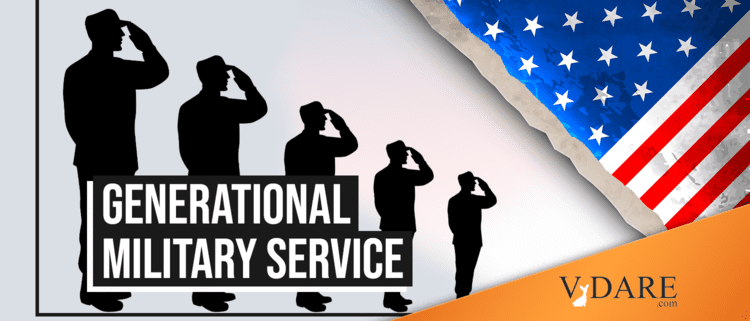
Military Becoming Increasingly Hereditary
By Steve Sailer
01/11/2020
From The New York Times news section:
Who Signs Up to Fight? Makeup of U.S. Recruits Shows Glaring Disparity
More and more, new recruits come from the same small number of counties and are the children of old recruits.By Dave Philipps and Tim Arango
Jan. 10, 2020COLORADO SPRINGS — The sergeant in charge of one of the busiest Army recruiting centers in Colorado, Sergeant First Class Dustin Comes, joined the Army, in part, because his father served. Now two of his four children say they want to serve, too. And he will not be surprised if the other two make the same decision once they are a little older. …
“Show me a better deal for the common person,” he said.
Soldiers like him are increasingly making the United States military a family business. The men and women who sign up overwhelmingly come from counties in the South and a scattering of communities at the gates of military bases like Colorado Springs, which sits next to Fort Carson and several Air Force installations, and where the tradition of military service is deeply ingrained.
More and more, new recruits are the children of old recruits. In 2019, 79 percent of Army recruits reported having a family member who served. For nearly 30 percent, it was a parent — a striking point in a nation where less than 1 percent of the population serves in the military.
For years, military leaders have been sounding the alarm over the growing gulf between communities that serve and those that do not, warning that relying on a small number of counties that reliably produce soldiers is unsustainable, particularly now amid escalating tensions with Iran.
… But the military families who have borne nearly all of the burden, and are the most cleareyed about the risks of war, are still the Americans who are most likely to encourage their sons and daughters to join.
… The main predictors are not based on class or race. Army data show service spread mostly evenly through middle-class and “downscale” groups. Youth unemployment turns out not to be the prime factor. And the racial makeup of the force is more or less in line with that of young Americans as a whole,
Whites got killed in Iraq and Afghanistan a lot more per capita because they tend to be more gung-ho about combat jobs. My estimate is whites were 89% more likely per capita than nonwhites to get killed in Iraq and 146% more likely in Afghanistan. (Those figures are not widely known, by the way. Who would be interesting in something as boring and trivial as that? Now back to baseball statistics!)
though African-Americans are slightly more likely to serve. Instead, the best predictor is a person’s familiarity with the military.

Black recruits tend to be the children of blacks who served. A 1997 book about recruiting by Moskos made the point that even by then there were a lot of two or three generation black families in the Army (less so in other branches), typically specializing not in combat but in supply paperwork jobs that could then transition to a civilian government job, with an ideal path of collecting two nice pensions. It’s a pretty sensible way to go through life.
… Many schools encourage students to take the military’s aptitude exam, the ASVAB, in the way students nationwide are pushed to take the SAT.
That exposure during school is one of the strongest predictors of enlistment rates, according to a 2018 report by the Institute for Defense Analyses. …
The situation is markedly different in regions where few people traditionally join.
In Los Angeles, a region defined by liberal politics where many families are suspicious of the military, the Army has struggled to even gain access to high schools. By law, schools have to allow recruiters on campus once a semester, but administrators tightly control when and how recruiters can interact with students. Access is “very minimal,” said Lt. Col. Tameka Wilson, the commander of the Los Angeles Recruiting Battalion.
Predictably, enlistment rates are low.
In 2019 the Army made a push to increase recruiting efforts in 22 liberal-leaning cities like Los Angeles. As part of that, Army Secretary Ryan D. McCarthy visited officials from the Los Angeles Unified School District in December to push for greater access.
“He was doing a sort of listening tour,” said Patricia Heideman, who is in charge of high school instruction for the school district and said there was a perception the military preys on disadvantaged students. “I told him from the educator perspective, we sometimes feel they are targeting our black and brown students and students of poverty,” she said. And therefore they are less likely to push enlistment.
In reality, the ASVAB/AFQT enlistment test is a big barrier.
Even within one state there are striking differences in how communities view military service. Colorado Springs produced 29 times as many enlistments in 2019 as nearby Boulder, a liberal university town.
Colorado Springs has about 4+ times as many people as Boulder, so the per capita difference is a little over 6 to 1.
The article ends with a nice human interest story about a young woman from Boulder who went to pricey Middlebury College, famous for ski bums and punching Charles Murray, but really wanted to be a K-9 officer so she’s finally enlisted.
Tom Wolfe implied in his 1979 book The Right Stuff that the military officer corps was becoming more hereditary 60 years ago:
… for a good thirty years, the rising business classes in the cities had been steering their sons away from the military, as if from a bad smell, and the officer corps had never been held in lower esteem. Well, career officers returned the contempt in trumps.
